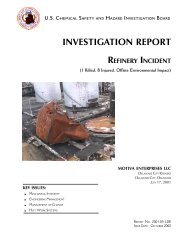CTA Report, Draft 1, ISP Review - US Chemical Safety and Hazard ...
CTA Report, Draft 1, ISP Review - US Chemical Safety and Hazard ...
CTA Report, Draft 1, ISP Review - US Chemical Safety and Hazard ...
You also want an ePaper? Increase the reach of your titles
YUMPU automatically turns print PDFs into web optimized ePapers that Google loves.
Plant personnel reported that the February 20 explosions caused large amounts of dust that had collected<br />
on overhead surfaces (e.g., on top of blend rooms, beams, ledges) to descend upon them. CSB found<br />
accumulations of combustible dust burned onto flat surfaces in the <strong>CTA</strong> production area. However,<br />
because of the extensive fire <strong>and</strong> explosion damage, CSB could not determine the thickness of the dust<br />
layer on flat surfaces prior to the fire.<br />
Housekeeping involved cleaning floors <strong>and</strong> plant equipment on a daily basis. In the year prior to the<br />
incident, the facility’s housekeeping crew for this type of cleaning was reduced in size. The reduced crew<br />
was able to clean a limited area within the plant each day. Daily housekeeping on production lines<br />
became a job duty of line operators.<br />
The <strong>CTA</strong> cleaning program focused on production line, floor, <strong>and</strong> baghouse cleaning. It did not<br />
adequately address other flat surfaces such as I-beams, process ducts <strong>and</strong> pipes, roof trusses, <strong>and</strong> the top<br />
of the blend rooms. Semi-annual cleanings (Section 4.4) during plant shutdowns were supposed to be<br />
scheduled; however, CSB did not find evidence that these cleanings occurred. Housekeeping inspections<br />
did not detect accumulations of combustible dust that could not be seen at floor level.<br />
Good housekeeping is critical for combustible dust control. NFPA 654 (2000) states: “[R]egular<br />
cleaning frequencies shall be established for floors <strong>and</strong> horizontal surfaces, such as ducts, pipes, hoods,<br />
ledges, <strong>and</strong> beams, to minimize dust accumulations within operating areas of the facility.” It further<br />
recommends that spaces inaccessible for cleaning be sealed to prevent dust accumulation <strong>and</strong> that<br />
combustible dust inspection programs specifically address housekeeping. A more effective housekeeping<br />
program at <strong>CTA</strong> would have limited the buildup of combustible dust.<br />
8.5.3 Nonroutine Operations<br />
The doors on the line 405 oven were left open because the oven was operating too hot. Personnel viewed<br />
the temperature control problem exclusively as a product quality concern, so the safety hazard of<br />
74









